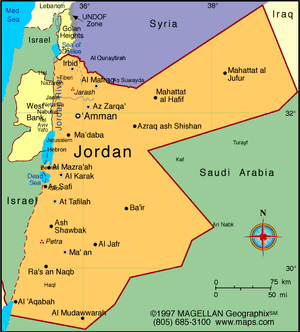Aqaba
| Author:Laxman Burdak, IFS (R) |

Aqaba is the only coastal city in Jordan and the largest and most populous city on the Gulf of Aqaba.[1]
Variants
- English: /ˈækəbə/,[2]
- Arabic: العقبة,
- romanized: al-ʿAqaba, al-ʿAgaba, pronounced [æl ˈʕæqaba, alˈʕagaba]
- Al-ʿAqabah/Al ʿAqabah
- Elath
- Ailath
- Aila
- Aela
- Haila
- Ælana/ Aelana (Pliny.vi.32)
- Ayla
Jat clans
Location
Situated in southernmost Jordan, Aqaba is the administrative centre of the Aqaba Governorate.[3] Today, Aqaba plays a major role in the development of the Jordanian economy, through the vibrant trade and tourism sectors. The Port of Aqaba also serves other countries in the region.[4]
Name
The name of the city was anciently Elath, Ailath. The name is presumably derived from the Semitic name of a tree in the genus Pistacia.[5] Modern Eilat (established 1947), situated about 5 km north-west of Aqaba, also takes its name from the ancient settlement. In the Hellenistic period, it was renamed Berenice (in Greek Βερενίκη), but the original name survived, and under Roman rule was re-introduced in the forms Aila,[6] Aela or Haila, adopted in Byzantine Greek as Άιλα Aila and in Arabic as Ayla (آيلا).[7] The crusaders called the city Elyn.[8]
The present name al-ʿAqaba (العقبة) is a shortened from ʿaqabat Aylah (عقبة آيلة) "the mountain-pass of Ayla", first mentioned in the 12th century by Idrisi, at a time when the settlement had been mostly reduced to a military stronghold, properly referring to the pass just to the north-east of the settlement (29.559°N 35.095°E, now traversed by Aqaba Highway).[9][10]
History
Aqaba's strategic location at the northeastern tip of the Red Sea between the continents of Asia and Africa has made its port important over the course of thousands of years.[11]
The ancient city was called Elath, adopted in Latin as Aela and in Arabic as Ayla. Its strategic location and proximity to copper mines made it a regional hub for copper production and trade in the Chalcolithic period.[12] Aela became a bishopric under Byzantine rule and later became a Latin Catholic titular see after Islamic conquest around AD 650, when it became known as Ayla; the name Aqaba is late medieval.[13] The Great Arab Revolt's Battle of Aqaba resulted in victory for Arab forces over the Ottoman defenders.[14]
Aqaba's location next to Wadi Rum and Petra has placed it in Jordan's golden triangle of tourism, which strengthened the city's location on the world map and made it one of the major tourist attractions in Jordan.[15]
Mention by Pliny
Pliny[16] mentions Arabia....We then come to a gulf which runs far into the interior, upon which are situate the Lænitæ, who have given to it their name; also their royal city of Agra44, and upon the gulf that of Læana, or as some call it Ælana45; indeed, by some of our writers this has been called the Ælanitic Gulf, and by others again, the Ælenitic; Artemidorus calls it the Alenitic, and Juba the Lænitic. The circumference of Arabia, measured from Charax to Læana, is said to be four thousand six hundred and sixty-six miles, but Juba thinks that it is somewhat less than four thousand. Its widest part is at the north, between the cities of Heroopolis and Charax. We will now mention the remaining places and peoples of the interior of Arabia.
44 Probably in the district now known as Akra. It was situate on the eastern coast of the Red Sea, at the foot of Mount Hippus.
45 See B. v. c. 12, where this town is mentioned.
References
- ↑ "Aqaba". The American Heritage Dictionary of the English Language (5th ed.). HarperCollins.
- ↑ Jones, Daniel (2003) [1917], Peter Roach; James Hartmann; Jane Setter (eds.), English Pronouncing Dictionary, Cambridge: Cambridge University Press, ISBN 3-12-539683-2
- ↑ "Fact Sheet". Aqaba Special Economic Zone Authority. Aqaba Special Economic Zone Authority. 2013.
- ↑ "Port expansion strengthens Jordanian city of Aqaba's position as modern shipping hub". The Worldfolio. Worldfolio Ltd. 27 February 2015.
- ↑ Grinzweig, Michael (1993). Cohen, Meir; Schiller, Eli (eds.). "From the Items of the Name Eilat". Ariel (in Hebrew). Ariel Publishing (93–94: Eialat – Human, Sea and Desert): 110.
- ↑ TSAFRIR, YORAM (1986). "The Transfer of the Negev, Sinai and Southern Transjordan from 'Arabia' to 'Palaestina.'". Israel Exploration Journal. Israel Exploration Society. 36 (1/2): 78. JSTOR 27926015.
- ↑ The Umayyads: The Rise of Islamic Art. AIRP. 2000. p. 183. ISBN 978-1-874044-35-2.
- ↑ Steven Runciman (1952). A History of the Crusades: The Kingdom of Jerusalem and the Frankish East 1100-1187. Vol. 2. Cambridge University Press. p. 79.
- ↑ Moshe Sharon (1997). Corpus Inscriptionum Arabicarum Palaestinae. Vol. 3. p. 89.
- ↑ Yoel Elitsur (2004). Ancient place names in the Holy Land. Magnes Press. p. 35.
- ↑ "Port expansion strengthens Jordanian city of Aqaba's position as modern shipping hub". The Worldfolio. Worldfolio Ltd. 27 February 2015.
- ↑ Florian Klimscha (2011), Long-range Contacts in the Late Chalcolithic of the Southern Levant. Excavations at Tall Hujayrat al-Ghuzlan and Tall al-Magass near Aqaba, Jordan,
- ↑ العقبة.. ثغر الاردن الباسم". Ad-Dustor Newspaper. Ad-Dustor Newspaper. 21 June 2013.
- ↑ "Jordan tapping popularity of UEFA Champions League to promote tourism". The Jordan Times. The Jordan News.
- ↑ "Jordan tapping popularity of UEFA Champions League to promote tourism". The Jordan Times. The Jordan News.
- ↑ Natural History by Pliny Book VI/Chapter 32

